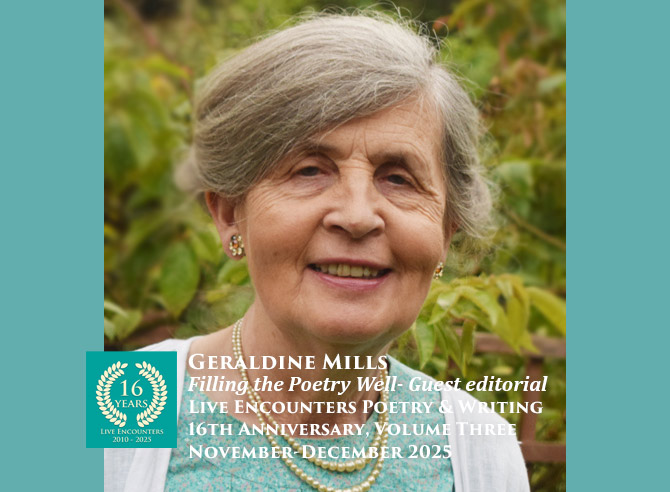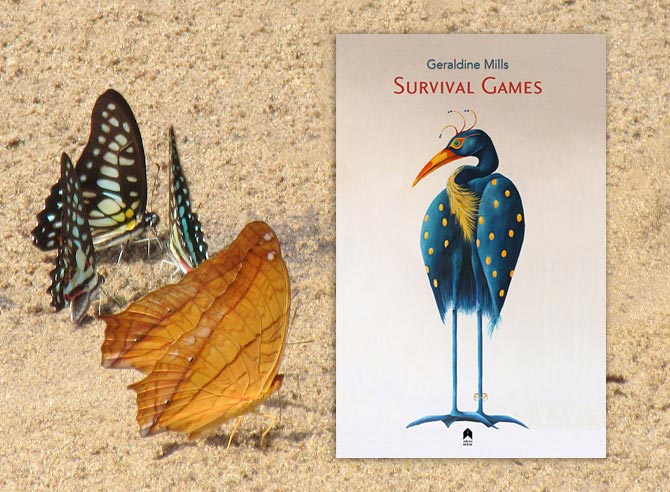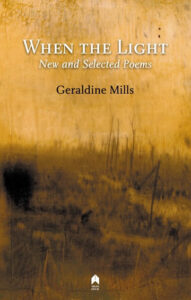
Live Encounters Poetry & Writing 16th Anniversary Volume Three
November- December 2025
Filling the Poetry Well, guest editorial by Geraldine Mills.
Survival Games by Geraldine Mills will be launched on 21st Oct at 6 p.m. in the Teachers Club in Dublin
and at Charlie Byrne’s Bookshop on 26th Oct at 6 p.m. Thereafter, it will be available at :
https://www.kennys.ie/
https://charliebyrne.ie/
https://booksupstairs.ie/

There was a field. There was a woman. She had a dream to build a garden to celebrate Brigit, goddess/saint of Celtic Ireland. Land was bought, plans drawn up, trees planted, a garden shaped to honour the seasons of the Celtic calendar. Saplings soon rooted, thrushes came, a robin. Tortoiseshell butterflies, orchids. The vision came into being.
Brigit is the goddess/saint of healers, smiths, poets and childbirth. There is the story of Brigit, the saint, who requested a piece of land from the king of Leinster to build her convent. When he refused, she asked if he would give her as much space as her cloak would cover. He agreed. She spread it on the ground in front of her and it started to stretch across the land until it had covered many acres.
Like the cloak, this field in County Galway, Ireland grew too. From its small beginnings it now claims 11 acres of native woodland, meadows, pond, and the four gardens of Samhain, Imbolg, Bealtaine and Lunasa, the seasons that celebrate the Celtic year.
The reason I mention this is that the founder, the woman with the dream, Jenny Beale, asked me to be part of a new poetry trail around the garden this autumn with seven other Galway poets. Our task was to write new poems in response to the garden and a selection of them would be chosen and displayed for visitors.
For months I had been searching for a road that would lead me back into writing. I knocked on many doors, the words didn’t answer. I lowered the bucket into the well and only pulled up silt and dead insects. I gave the page roses; it gave me back snakes. I offered the white space apples; it spat back scorpions.
Carl Jung said that ‘the creative mind plays with the objects it loves’, and so before I could start any work on the garden poems, I knew I needed to come to it from a sense of richness, instead of poverty. The way that has worked for me in the past is to play with the things that bring me joy: words and their meaning.
Since my early college days, when I studied science, I have never failed to be amazed by the beauty of the word ‘photosynthesis’, which means: to make with light, and it does just that. It was the Dutch scientist, Dr Jan Ingen Housz who discovered that light is necessary for plants to give out oxygen. That carbon dioxide and water in the presence of sunlight striking chlorophyll are miraculously converted to glucose and give out oxygen as a byproduct. It is what keeps us alive. Creates food for the living chain. Allows us to breathe. Studying the glucose molecule fills me with awe. How does this happen? How did this come about? Mere accident or a brilliant designer? I will never know but it is the jewel in the crown of biochemistry that makes up life as we know it.
It reawakens my curiosity.
Boustrophedon is a word I can barely pronounce but I am entranced by the way it gets its name from the Greek word for ‘ox’ and ‘turn’. It was a style of writing used by ancient Greek inscribers, especially on stone, before the standard left to right style came into use, as we know it today in this part of the world. Boustrophedon is where alternate lines of writing are reversed, with letters also written in reverse. Thus, the pattern builds, turning alternate lines in the same way the working animal alternates its ploughing along the field.
I take out one of my old poems and try it. Every alternate line and letter I write backwards. It is strangely satisfying. There is complete focus needed to write each letter in reverse. My mind becomes accustomed to it, everything else blocked out as I shape letters as if a child who has just begun to write. I come to the end of the line. Turn it and the letter just like the ox ploughing. It releases something in me. The beginning of richness.
I learn new words for yellow – Realgar, Orpiment, Gamboge.
My imagination continues to be sparked by the vivid travels of Albrecht Dürer. When his patron, Maximillian died, this painter left the impoverished streets of Nurenburg in 1520, took to travelling with his wife and maid. A year long trip by horse, by boat to the coast to search out a new patron. He traded along the way his priceless art for two parrots in a cage, a piece of red chalk, a buckler of fish-skin. He bought himself a pair of socks for one stiver and stopped to sketch the bones of a giant. The sun burning his neck as he drew. Birds clamouring to be heard. I wonder what he would have made of the huge scapula, that enormous thigh bone?
I discover Enheduanna, who is celebrated as the earliest known poet in history. Born in 2286 BC, around the time of the invention of writing, her father, Sargon, ruled over ancient Mesopotamia (encompassing modern-day Iraq, Kuwait) where Enheduanna became the high priestess of the moon god, Nama, at the temple at Ur. She died 35 years later.
In 1927, British archaeologist, Leonard Woolley excavated the ancient city of Ur where he discovered the ruins of a temple. There he found stone discs, depicting Enheduanna standing in worship beside a libation bearer. Two seals with her name on it show the ‘Exaltation of Inanna’, one of the poems of 154 lines written to the goddess, Inanna, in which Enheduanna beseeches her to intervene in the conflict that has driven her into exile. She attributes the success of her return home to the power of the goddess, and she writes in the exaltation, ‘Be it known that you devastate the rebellious land’. So important was she that her work was one of the ten texts used in schools for scribes and is the main reason why her work has survived to this day.
While there has been much debate as to whether a woman could possibly be the first author, the Morgan Library and Museum in New York consider the evidence strong enough to have hosted an exhibition in her honour in 2023.
I like to think of this woman who lived fifteen hundred years before Homer, 1700 years before Sappho and even longer before Aristotle, sitting with her clay tablet on her knee, and with her reed stylus inscribing words that depicted her every day: issues such as her insecurities, abuse, her usurper, even the difficulty of writing a poem. At this point, I can relate to her creative struggles.
I have, however, given myself enough riches to begin my poetry project. It is a soft day as I arrive at the garden and step through the interlinking sections, each representing one of the Celtic festivals, through the cycle of the year, from birth to death. The earth in the shape of a sleeping woman curves around a womb-like pool. Birch woman bends to the dark, listens. There is tree man with his arms outstretched; the robin that knows the best places to catch a crumb falling.
There are the hazels with their little husk hats, the brushes sweeping time across the sundial.
I stand before the spindle tree. It is laden with prayer fruit. The tree where people write their wishes, on coloured squares of paper. It holds all their hopes and worries. One asks for a magical wedding day, another hoping that fairies are real, another again that their hair will grow, that they will get a new home. The one wish that is asked for, over and over again, is the longing for peace. So many longings for peace. I take up my pen and start.
© Geraldine Mills
 Geraldine Mills is an award-winning poet and short story writer who lives in the west of Ireland. She is the author of six collections of poetry, three of short stories and two children’s novels. She is the recipient of many awards including the Hennessy New Irish Writer Award, three Arts Council Bursaries and a Patrick and Katherine Kavanagh Fellowship.
Geraldine Mills is an award-winning poet and short story writer who lives in the west of Ireland. She is the author of six collections of poetry, three of short stories and two children’s novels. She is the recipient of many awards including the Hennessy New Irish Writer Award, three Arts Council Bursaries and a Patrick and Katherine Kavanagh Fellowship.
Her fiction and poetry have been on curricula of contemporary literature courses in a number of US universities and the USA summer programme at the Burren College of Art. Her fourth short story collection, titled Survival Games is forthcoming from Arlen House in the autumn.

